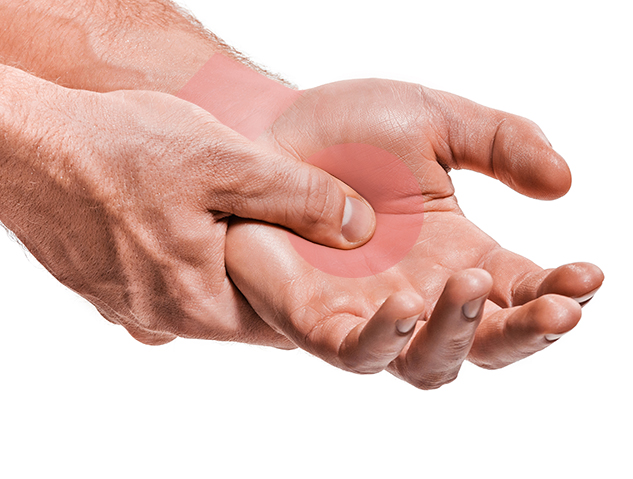Hand & Wrist Conditions & Treatments

It is common for hand and wrist pain to be caused by sprains or fractures from an injury. Because wrist pain can result in long-term issues, a proper diagnosis is crucial. These long-term issues could stem from a sudden injury. These injuries are arthritis, repetitive stress, and carpal tunnel syndrome.
Depending on the cause of your wrist pain, the pain level and description may vary. The pain described is typically similar to a dull toothache, pins and needles sensation or tingling.
Hand & Wrist Pain Causes
Wrist pain often occurs from sudden impacts injuries, such as falling forward onto an outstretched hand. A fall such as this can cause strains, sprains, and even fractures.
If you are experiencing wrist pain from a sudden impact, a sprain, or a fracture, call us immediately. To make an appointment with our award-winning hand specialist, call 888-409-8006.
Another type of injury could result from repetitive stress. This occurs from any activity which involves a repeated movement. An example would be hitting a tennis ball. And performing motions such as these can inflame the tissue around joints or cause a stress fracture. This typically occurs when you are performing hours of movement without rest.
Common Hand / Wrist Pain Conditions:
- Osteoarthritis: This disease happens from the wear and tear of the joints. Pain and stiffness in joints could be the cause of hand osteoarthritis. The older you are, the more likely you are to experience this condition. Women are also twice as likely to experience osteoarthritis than men.
- Carpal Tunnel Syndrome: A patient who experiences numbness, tingling, or weakness in the wrist is usually experiencing carpal tunnel. Carpal tunnel syndrome is due to excess pressure in the wrist and on the median nerve. When inflammation occurs, it is typically due to an underlying medical condition. This causes swelling and painful wrists.
- Dupuytren’s contracture: Dupuytren’s disease (aka Dupuytren’s contracture) is a hand deformity. This disease is a slow-progressing condition and can take many years to develop fully.
- Ganglion cysts: Ganglion cysts typically develop along with the tendons or joints of your wrist or hands. These particular cysts are noncancerous and are usually painless. Although, if a cyst presses on a nerve, it can cause tingling, pain, numbness, or muscle weakness.
- Kienbock’s Disease: This disorder typically affects young adults. Kienbocks disease involves the progressive collapse of small bones in the wrist. It occurs when the blood supply to the bone is in jeopardy.
Common Hand / Wrist Pain Injuries:
- Wrist Tendonitis: Wrist tendonitis is a common condition, and is caused by repetitive daily stress. This condition often occurs with playing sports, typing on a computer, writing, or physical work.
- Wrist Fracture: A wrist fracture occurs in any of the 10 bones surrounding it. Although any of the ten bones can break, the most common wrist fracture is in the radius. This type of fracture occurs from an injury such as falling and landing on a hand stretched-out
Hand & Wrist Pain Treatments
A typical treatment for hand & wrist pain includes rest, pain relievers, or ice & heat. When conservative options fail, your physician might suggest other options, such as surgical treatments.
Non-operative Hand & Wrist Treatments
- Corticosteroid Injection: A cortisone injection may help to relieve pain and inflammation in a specific area of your body. This injection typically includes a corticosteroid medication and a local anesthetic.
- Trigger Point Injection: The trigger point injection (also known as TPI) is used to treat pain in certain areas in the body that contain knots of muscle that form when muscles don’t relax.
- Platelet Rich Plasma (PRP): Platelet Rich Plasma injections may help damaged tissue when plasma is injected into the damaged tissue to stimulate your body to grow new healthy cells and promote healing.
Surgical Hand & Wrist Procedures
- Carpal Tunnel Release: This procedure is performed by your surgeon by trimming the ligament around the carpal tunnel. This is done to release pressure from the median nerve and relieve wrist pain. Following the surgery, the ligament will reattach itself. However, it does so with more room for the median nerve to pass through.
- Ganglion Cyst Removal: When surgical options are necessary, the surgeon will remove the cyst and the stalk which attach the joint or tendon.
- Revasculation: This is another surgical option for people suffering from Kienbock’s Disease. This particular procedure is used to help stop the disease from progressing further. At times, removing or grafting a piece of bone is necessary. This will relieve pressure on the lunate.
- Tendonitis Surgery: During a wrist tendonitis procedure, the surgeon will make a small cut near the affected area. Next, any scar tissue in the surrounding area will be removed, which gives the tendons greater mobility. If necessary, the surgeon will then make sutures.
